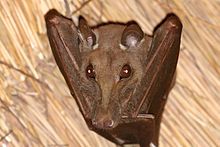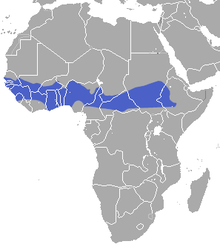This article has multiple issues. Please help improve it or discuss these issues on the talk page. (Learn how and when to remove these messages)
|
| Gambian epauletted fruit bat | |
|---|---|

| |
| Scientific classification | |
| Domain: | Eukaryota |
| Kingdom: | Animalia |
| Phylum: | Chordata |
| Class: | Mammalia |
| Order: | Chiroptera |
| Family: | Pteropodidae |
| Genus: | Epomophorus |
| Species: | E. gambianus
|
| Binomial name | |
| Epomophorus gambianus (Ogilby, 1835)
| |

| |
| Gambian epauletted fruit bat range | |
| Synonyms | |
| |
The Gambian epauletted fruit bat (Epomophorus gambianus) is a species of megabat in the family Pteropodidae. It is found in Benin, Burkina Faso, Cameroon, Central African Republic, Chad, Democratic Republic of the Congo, Ivory Coast, Ethiopia, Gambia, Ghana, Guinea, Guinea-Bissau, Liberia, Mali, Niger, Nigeria, Senegal, Sierra Leone, South Sudan, Sudan, and Togo. Its natural habitats are subtropical or tropical dry forests and savanna.
Populations of epauletted fruit bats are threatened by pesticides on fruit, human disturbance and over-collecting in the past. However, the number one reason it may be threatened is habitat destruction.
Mostly found in Africa, these creatures have grayish-brown color fur with a white patch at the base of their ear in both males and females. These fruit bats are also very noisy creatures. In the context of mating behavior (see "Reproduction" below), adult males may hang from perches and perform a calling-display during which they utter a moderately loud bell like 'ping' at intervals of 1–3 seconds.[2]
It is very easy to tell the male fruit bat from the female fruit bat. In comparison, males are usually larger than females. The males also have gland-like pouches in the skin of their shoulder, that is surrounded by light colored patches and/or tufts of fur. Thus, one of the reasons why they are named Gambian epauletted fruit bats, it produces the effect of epaulettes; a decorative or ornamental piece. The only way one would be able to see the epaulettes is when the male becomes stressed or sexually stimulated. Both males and females have small rounded ears, with a dog-like muzzle.[3]
Their head and body length are usually 125–250 mm (5–10 in) and their wing span is about 508 mm (20 in) for the males. Mass ranges from 40 to 120 g (1.4 to 4.2 oz) and forearms are about 60–100 mm (2–4 in). This creature also has a tail that is hard to detect beneath the inter femoral membrane.[4][5][6][7]
The species is known to hang off of evergreen trees during the day alone or spread out from one another and travel in packs of hundreds during the late hours of the night in the forest of Africa.
- ^ Tanshi, I.; Fahr, J. (2016). "Epomophorus gambianus". IUCN Red List of Threatened Species. 2016: e.T7903A22122670. doi:10.2305/IUCN.UK.2016-2.RLTS.T7903A22122670.en. Retrieved 17 November 2021.
- ^ Kingdon, Jonathan (2013). Mammals of Africa, Volume IV: "Hedgehogs, Shrews and Bats". A&C Black. ISBN 9781408189962.
- ^ Neuweiler, Gerhard (2000). The Biology of Bats. Oxford University Press. ISBN 9780195099508.
- ^ Fenton, M Brock (1992). Bats. Facts on File. ISBN 0816026793.
- ^ Hill, John E; Smith, James D (1984). Bats, A Natural History. University of Texas Press. ISBN 0292707525.
- ^ Kunz, Thomas; Racey, Paul (1998). Bat Biology and Conservation. Smithsonian Institution Press. ISBN 1560988258.
- ^ Wimsatt, William A (1970). Biology of Bats. Academic Press. ISBN 9780127580012.
